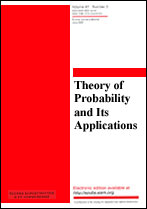|
This article is cited in 1 scientific paper (total in 1 paper)
Short Communications
A game with optimal stopping of random walks
V. V. Mazalov, È. A. Kochetov
Chita Institute of Natural Resources SB RAS
Abstract:
A two-person game $\Gamma$ is considered which is specified by the following random walks. Let $x_n$ and $y_n$ be independent symmetric random walks on the set $E=\{0,1,\ldots,K\}$. Assume they start from the states $a$ and $b$ respectively $(1\le a < b\le K-1)$, are absorbed with probability $0.5$ at points $0$ and $K$, and are reflected to the points $1$ and $K-1$, respectively, with the same probability $0.5$. Players I and II observe the random walks $x_n$ and $y_n$, respectively, and stop them at Markov times $\tau $ and $\sigma$ being strategies of the game. Each player knows the values of $K, a$, and $b$ but has no information about the behavior of the other player.
The rules of the game are as follows. If $x_{\tau} > y_{\sigma}$ then player II pays player I, say, \$1; if $x_{\tau} < y_{\sigma}$ then I pays II \$1; and if $x_{\tau}=y_{\sigma}$ then the outcome of the game is said to be a draw. The aim of each player is to maximize the expected value of hisincome.
We find the equilibrium situation and the value of the game.
Keywords:
random walk, reflecting barriers, strategy, stopping time, spectrum, equilibrium situation.
Received: 31.07.1996
Citation:
V. V. Mazalov, È. A. Kochetov, “A game with optimal stopping of random walks”, Teor. Veroyatnost. i Primenen., 42:4 (1997), 820–826; Theory Probab. Appl., 42:4 (1998), 697–701
Linking options:
https://www.mathnet.ru/eng/tvp2611https://doi.org/10.4213/tvp2611 https://www.mathnet.ru/eng/tvp/v42/i4/p820
|


|




 Contact us:
Contact us: Terms of Use
Terms of Use
 Registration to the website
Registration to the website Logotypes
Logotypes








 Citation in format
Citation in format 
